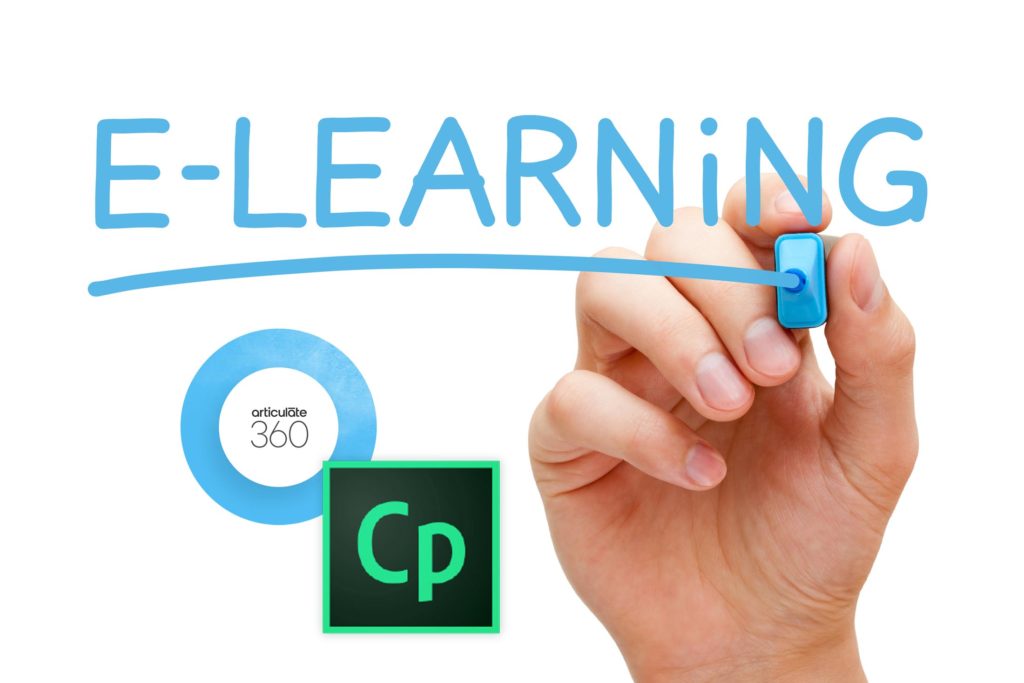If you’re looking to create interactive learning experiences, you’ll need a reliable tool. With many tools available, learning designers have some tough choices to make. It’s hard to say which tool is better. Each one has certain pros and cons, and other factors such as the type of learning you’re developing come into play as well. This article looks at two of the more popular tools, Adobe Captivate and Articulate 360, to better understand the features of each.
Both tools have released new versions for 2017. Articulate 360 is a giant leap forward because the latest release bundles together all of Articulate’s apps and resources into a single subscription. The new release effectively overcomes some of Articulate’s previous shortcomings, such as responsive design and team-based authoring. Performance-wise, the new release makes Articulate more competitive with Captivate.
User interface
Both tools have an intuitive interface.
Captivate is user-friendly. The interface includes easy-to-use on-screen objects, containers, and other assets to create highly interactive learning experiences and simulations without programming knowledge. Existing users will recognize Captivate’s viewing options, including the timeline and filmstrip, along with control panels for media integration and other property controls. With the 2017 release, Adobe introduced fluid boxes, which enable you to draw containers for responsive design (more about that under “User experience.”)
Many designers, however, might find Articulate easier to use. Articulate has its roots as a PowerPoint enhancement tool, and even today the interface is similar. Any designer who has used PowerPoint will feel comfortable with Articulate’s interface. Articulate offers views that let you work on projects at the slide level or from the story level, which allows you to organize layout and navigation for a project.
Responsive design
Designers of any level can create an engaging and highly interactive learning experience with either package. Two key aspects of the output are responsive design and accessibility. In the past, Captivate had the leg up on those two areas. But the latest version of Articulate narrows the gap.
Both tools now offer responsive design. This is a significant consideration with the use of mobile technology increasing every year. Even users who are still primarily computer-based tend to alternate with mobile use. They want a streamlined experience as they move across environments.
Captivate has supported responsive design for the past few releases. The 2017 version introduces fluid boxes, which let you draw responsive containers for holding your text and images. Set a few properties for each container to determine how the contents is handled in different viewing environments, and your responsive design is all set. You can also use the fluid boxes to convert non-responsive courses to a responsive format.
Articulate supports responsiveness through a free mobile app. In past versions of Storyline, the content did not really adapt for mobile use but just scaled down to fit the viewing screen. The result could be cluttered or unreadable. The 2017 release of Articulate 360 includes a new responsive player that detects the device screen size and orientation and then adapts the content accordingly. It is not necessary to build the responsive design into the course.
Accessibility
Accessibility support is critical. Both tools offer the capability to output learning content that complies with Section 508 and Web Content Accessibility Guidelines 2.0 (WCAG 2.0). This is particularly important for organizations working in the areas of defense, government, and education.
Captivate has long supported Section 508 accessibility guidelines with alt text, keyboard navigation, text equivalents, and, in recent versions, closed captioning. The 2017 version continues this support with improved auto-generated and customizable closed captioning. The latest version of Articulate offers similar support. Bottom line, accessibility is a deal-breaker in the digital learning industry. Both companies recognize this and support a full range of features for creating accessible content. You can’t go wrong with either tool.
Asset library
Both tools offer extensive asset libraries that include templates, images, themes, icons, media, and more. Users can also create and import their own assets in either tool. With Captivate, users gain access to a library of more than 75,000 free eLearning assets. In addition, users can purchase licensed assets from Adobe Stock. Articulate 360 boasts a library of more than 2 million assets. Without exploring the libraries, it’s hard to say which is better. But in either case, the assets available far exceed what many designers are likely to use.
Interactive elements
Users will not be at a loss for interactive elements with either tool. Both offer screen capture and screen casting capabilities and the ability to produce interactive tutorials and simulations.
Captivate offers various multimedia tools to enhance interactivities including audio synchronization, drag-and-drop relationships, quizzing, sliders, scenario branching, and pan-and-zoom support. This gives designers a wide range of options for creating interactive learning. Designers can use the stock interactions or customize them. They can also create and share their own interactions.
Articulate 360 likewise offers the ability to drop buttons, sliders, and other elements onto a slide to add instant interactivity. Designers can also create custom interactions without programming knowledge, along with personalization in their learning content.
Browser and platform compatibility
Captivate offers both a perpetual license and a subscription. Both options are installed locally on the user’s computer, and do not require an internet connection to work (note, however, you do need a connection to install and activate the product). Captivate is compatible with Microsoft Windows versions 7 (SP 1), 8.1, and 10 and Mac OS X v10.12.3+ (multicore Intel Processor) or iOS 10.2.1 for iPad. With the move to a subscription- and cloud-based model, Articulate 360 is now compatible with both Windows and Mac operating systems.
As for output, both tools offer popular formats that include pure HTML5. This is important as devices and platforms move away from supporting Flash. The output from both programs will integrate with LMSs that are Tin Can, SCORM, and AICC compliant.
For content viewing, Captivate supports Flash Player 10 or later in Internet Explorer versions 8 through 11 and the latest versions of Chrome and FireFox for Windows. For HTML5, Captivate supports Internet Explorer versions 9 through 11 and Microsoft Edge for Windows; the latest versions of Safari for Mac; and the latest versions of Chrome and FireFox for either operating system. For mobile viewing, Captivate supports the latest version of Safari for iOS 10 (or later) and the latest version of Chrome for Android 5.0 (or later).
Articulate fully supports Internet Explorer 11 and the latest versions of Microsoft Edge, Google Chrome, Firefox, and Safari for desktop/laptop viewing and authoring, and most Apple and Android browsers for mobile viewing. Articulate offers limited support for Internet Explorer 8 through 10.
Price
This is where decisions might be made. Captivate offers a full license for $1,099. Individual subscriptions are $29.99 per month and require an annual contract. Adobe offers a variety of licensing models discounts for enterprises, teams, educators, and multiple product purchases.
Articulate 360 has moved to a subscription- and cloud-based model; perpetual licenses are no longer supported for the latest release (note that Storyline 3 is still available with a perpetual license, but features are limited compared to 360). A single subscription is $999 annually for new users and $1,299 per user annually for new teams. The team plans include priority support options and expanded authoring capabilities for teams. Upgrade pricing is available.
While the choice will probably come down to personal preferences and budget, Captivate and Articulate are comparable as far as individual reviews go. Based on online reviews, Articulate has the upper hand on customer support and ease of use. Captivate has the more stable platform, and may be a better choice for team-based authoring.

